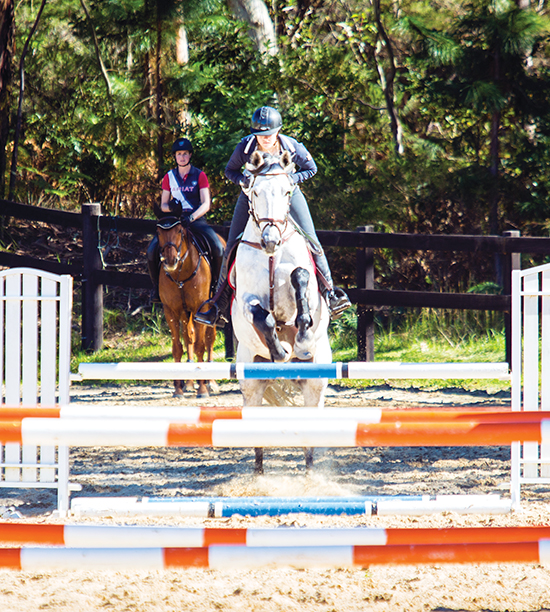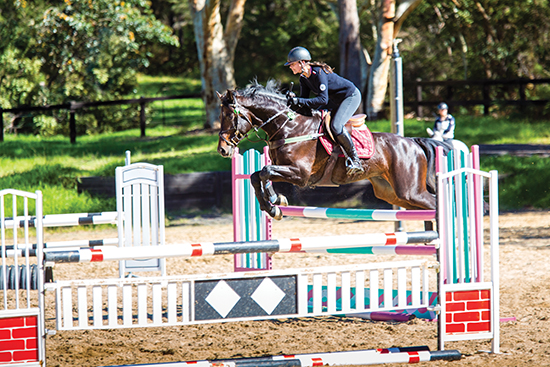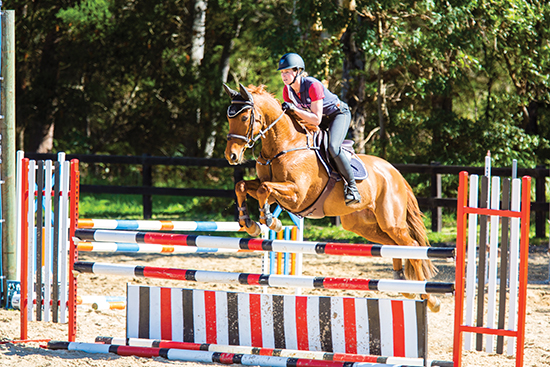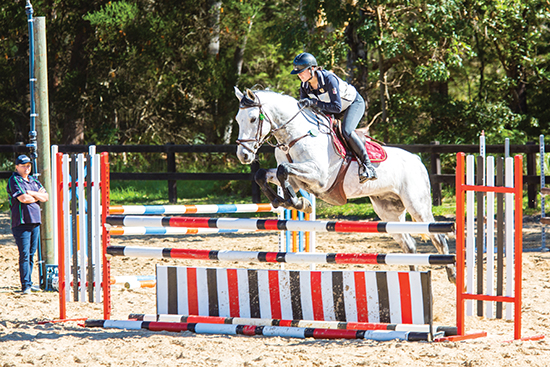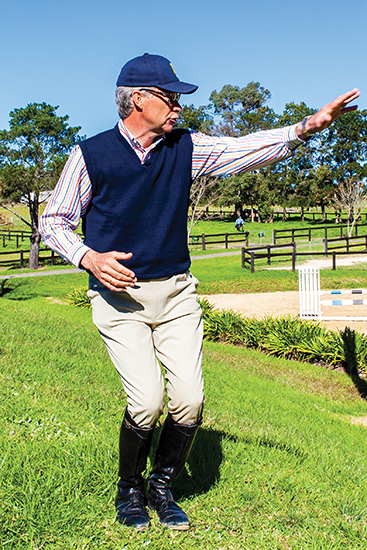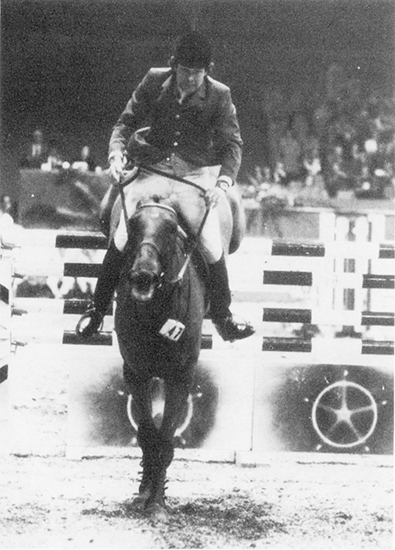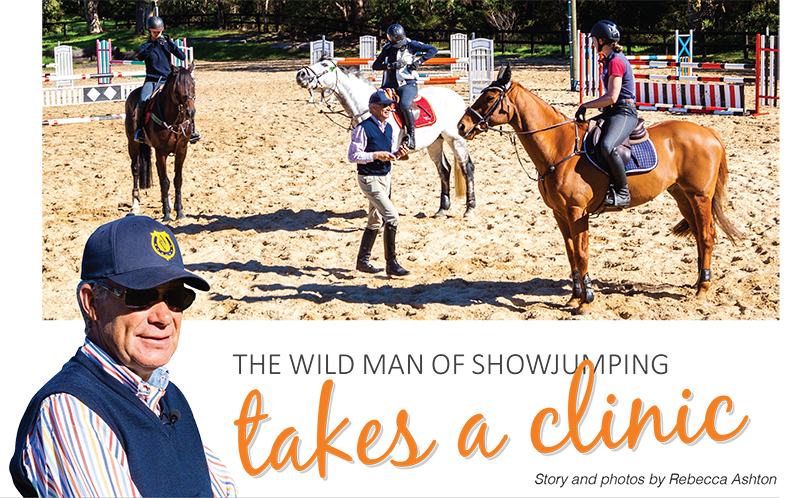 Albert Voorn is a legend but a very eccentric and outspoken legend. In an era when showjumping riders become more and more manufactured, right down to a phrase book of the ‘right’ things to say in any situation, Albert is not afraid to speak his mind, or question the prevailing orthodoxy… Rebecca Ashton sat in on the training clinic, and conducted the extraordinarily frank interview with the Dutch rider and trainer on his recent visit to Australia…
Albert Voorn is a legend but a very eccentric and outspoken legend. In an era when showjumping riders become more and more manufactured, right down to a phrase book of the ‘right’ things to say in any situation, Albert is not afraid to speak his mind, or question the prevailing orthodoxy… Rebecca Ashton sat in on the training clinic, and conducted the extraordinarily frank interview with the Dutch rider and trainer on his recent visit to Australia…
Albert Voorn speaks his mind. The Olympic silver medal winning showjumper says what he thinks, is clear on his ideas, goes straight to the point… and in doing so has succeeded in getting many a person off side. Does this make him intimidating and narrow minded? Confrontational perhaps, but even Albert would admit that. I found an incredibly open minded gentleman, still keen to learn and share ideas. He keeps things simple and definitely likes to do things his way, however, there is no arrogance with his approach to teaching. His sessions are peppered with many compliments and positive reinforcements and he obviously loves his job.
Krissy and Heath Harris’ picture perfect property at Mt White was where I saw the Dutchman in action. All the sessions had the same structure; loosening work to warm up on the flat then a single vertical with a focus on jumping on a circle line, single oxer and then onto a course. It was simple and to the point.
And the maestro begins, “Right, when you are mentally and physically ready, we trot! Rising. Just allow them a little bit to loop around. No problem. We are warming up. I heard you were riding rollkur yesterday. I don’t want to see rollkur. I see it and I shoot you! Just tell them where to go and what speed. Don’t think about collection or any of that.”
Voorn’s prime requisites were a good, upright position, clear aids and no chasing of the horse, who should be in front of the leg and in a good rhythm.
When horses and riders were relaxed and ticking along, Albert had his students put both reins in the outside hand “….to make sure that we are 100% relaxed, no tension in the body, but the body must not move. Also, being totally quiet does not mean being totally stiff. You must be aware of what you do so you can change what is wrong. If you are not aware, you cannot change it.
“This exercise is for your feeling, do not ride with the handbrake on. The horse should allow us to ride it forward. The moment we have to slam on the brake, there is no control.
“If he goes against you, spur him forward. Just two spurs and let go straight away otherwise they lock on it. Have a flexible foot so you can use the spur when you need it, but you need to keep asking yourself, ‘Can I ask less consistent spur?’”
“Now go faster. This is the progression. Our upper body is straight and we sit in the middle of the horse and we look where we go. Our seat is carrying our whole body weight. The pressure in your stirrup is no more than your foot.”
“Now, whole arena in a light seat with reins back in two hands. While you do it, think about your lower leg not moving backwards.”
“Canter change, allow your inside leg to go forward and make the change with the outside spur. Then reins in the outside hand again with slight flexion to the inside. When you feel the horse goes a little slower, it is the spur that makes him go forward, not the seat and the movement of the body. If you push with your seat, it opens the horse up too much and it’s hard for him to collect. Stay neutral in your position.”
When Danielle Butcher’s grey, Twins Capulet was resisting the spur, Albert helped, “Repeat. Keep repeating until he accepts it. Don’t avoid it.”
Danielle Butcher and Twins Capulet
The reins were then returned to two hands once more and everyone moved up a gear in pace. Each time the riders had their horses traveling nicely forward without pulling, the pace continued to increase. Albert explained, “Train this so that when they are in a jump off they don’t get a total shock!”
The next exercise in the sequence involved each rider circling around an individual jump at the canter with Albert conveying position corrections, some general and some directed at an individual, to make things smoother. “The stronger in your hand, the less pressure from the leg.”
“The length of rein should be a comfortable length but not so your elbows come behind the body because in that situation, you will want to grip with your upper leg.”
“When he’s too fast, then you slow him down with two hands, no leg pressure. Do it in a gentle way so he does not get upset by it. Both hands the same height.”
“On the circle, the outside rein gives but the inside rein is asking. The outside rein has to allow the horse to turn. If you lock the outside rein, you have no chance. Be consistent with the contact. We decide where to go and how fast, but in a gentle way.”
Just when you think you know Albert’s system, he changes it on you. “If they don’t get better with the flat work and they are ok jumping, I don’t do the flat work. Instead I lunge or put them on the horse walker. On the horse walker they can walk and trot for an hour. Then they come into the indoor and I canter, they drop their head and then I jump then they are on the horse walker walking for another hour and then into the paddock or stable.
Greer Schipp and Twins Easton VDL
“I want them to use up all their energy so they eat well and sleep well. One day a week I do not take them out of the box at all. It’s shocking? I don’t think so. They sleep all day.”
“In the paddock, you think they move a lot but really, consistent mileage is not there. They need to work. The paddock is better than sitting in the stable all day and not working, but it isn’t using energy.”
When it was time to start jumping, Voorn made sure all the riders were happy with the height of the jumps. He never forces anyone to do anything they’re not comfortable with, “We don’t jump things you don’t want to jump. It’s completely up to you. This is very important. My riders always decide what height, because if you fall on your nose, then what? You pay the bill in the end, so you decide. That goes for any coach you train with. You have to have the confidence and not be scared or hesitate.”
The Dutchman had the riders practice jumping a single vertical on a circle, making sure their distance was good, a correct rhythm was maintained and that they kept turning over the jump. Greer Schipp (nee Butcher) received the following advice, “Sometimes you have to insist on the turn at the top of the fence. I don’t care if they jump upside down, they have to want to turn. This helps you in a jump off.”
Despite the fact that Albert isn’t a believer in extra fitness for riders, he was doing a splendid job of running up and down the hill from his chair, racing helpers to put up jumps. “I can’t show them I am old!” he joked.
Jess Rae’s little chestnut Little Fish was being a tad troublesome but Voorn, who is well known for his effectiveness with more challenging horses, guided her, “For us as a rider when he pulls out that crap, it’s annoying, but we must not be annoyed. As soon as we get annoyed, we get tense. See how he is relaxing because he thinks it’s finished? Try to do this after every jump then, no, there is another one.”
Jess Rae and Little Fish
Then the little chap threw in a refusal. “It’s ok. Show him the fence. Pat him. Pat him.” Jess was slow to respond and Albert joked, “Is there a different Australian word you use?” But then success, “Two thumbs up for Jess. That was great! I’m very impressed.”
That’s the thing with Voorn, a compliment and encouragement is never very far away with an explanation why he thought the rider did so well. After a good round on her stallion, Twins Easton VDL, Greer was praised, “I love the way you waited. You did it with so much patience. Due to your patience, the horse stayed very relaxed and didn’t pull you into the distance. Very, very good.”
And to sister Danielle, “When you were slowing down, you used your rein and squeezed with your upper leg. Instead, let your lower leg move forward to take the pressure of the leg off. Don’t worry because you’re doing your best. You have so many good moments, but you have to try these different techniques.”
Danielle Butcher and Twins Capulet
It was Jess’s turn to jump again, “When you are on a course or after a single fence, don’t forget to take a deep breath or else you get to the end of your course and you’re exhausted. The deep breath will relax you and also relax your horse.”
With a lovely round completed, Albert was chuffed, “You do not have a crazy, difficult Thoroughbred. Piece of cake, isn’t it?! There are so many theories about what horses should or shouldn’t do. All your horse needs to know is hand to slow, leg for forward, left rein to turn left and right rein to turn right. The rest is crap, bullshit, unnecessary. We get bored as riders and do other things like shoulder in. You cannot make a bad jumper a good jumper but you can make a good jumper bad.
“Why should a horse jump round if 90% jump hollow? Allow the horse to jump in a way that is easiest for that particular horse. If you want a horse that jumps round, buy one! We as riders have to adapt to the horse. It saves you a lot of grey hairs. That is why at my age I have not so many grey hairs yet!”
Albert opens up to Rebecca…
Have you been back to Australia since your silver medal win at the Sydney Olympics?
I was National coach 20 years ago in 1996-98, but no, I haven’t been back since the Olympic Games. At the end of the day you go where you are invited. If people don’t invite you, you can’t go. I’m not begging people. It’s also more or less coincidence. First you are there, and then you’re not there and then you’re forgotten then what happened was that Paula Hamood saw a horse on a video in Europe that she was interested in then she sent me a message would I mind riding it and give my opinion on it and that’s what I did. Then she asked if I would mind coming out for a clinic so it lead from one thing to another.
You’ve only had three days here so far, but what’s been your opinion?
Yeah let’s say worldwide people ride exactly the same. There is no difference anymore. The thing is there are so many ways to do things on a horse and as long as the horse accepts what you’re doing and it makes it successful, probably it’s the right thing to do. Due to the clinics that you give and the different people you deal with, different horses that you deal with, you have to come to a system that suits everybody otherwise, you have always people who are very unhappy when they leave.
Finally at the end of the day, all that we do is to amuse ourselves that we are happy and when the clients leave they are content because they pay money and they want value for their money and they need to be satisfied about what they get.
You were saying during one lesson to let the horse do what it needs to do to be successful…
Yeah I think there are so many discussions about what is right and what is wrong, I think the only right way of riding, the only correct way, is the way that respects the natural functioning of the human being and the animal. At the moment that you respect that, the problems you run into are very, very little. There are no problems, there are only solutions.
And you were saying earlier the horse doesn’t like or need shoulder in. Do you not do any lateral work with your horses?
No, let’s say it’s nice to do it to amuse yourself and make the horse do a trick, but it has absolutely no positive influence on the way a horse jumps. It even can have a negative influence.
Do you think then that dressage and jumping should be kept as separate disciplines? Or do you indeed think dressage is a pointless pursuit?
No, no, no definitely not because I love dressage if it’s done well, which is not the case today anymore.
Do you think there are any riders competing in dressage today that you would say, “That is the right way.”?
I would say at the moment Charlotte Dujardin with Carl Hester stands out because you had Sjef Janssen. Anky Van Grunsven and Sjef were the worst thing to happen to the sport and it put dressage in discredit. The sport got a lot of criticism. What happened, and it is a very funny thing what happened, is that judges went along with Anky and Sjef and they started to accept that what they did was the right thing, because what they totally abandoned was the rule book of the FEI, how it’s explained how dressage should be ridden and they do not judge according to that anymore. If they did, riders would ride totally differently, would sit totally differently on their horse, they would ride in totally different saddles. It would be a totally different ball game.
But judges went along with it. Luckily we had then Carl Hester from England and luckily the English started to win and that changed a little bit let’s say the ones that are winning. But still, we in Holland, still ride like Sjef Janssen and all this physical strength and this is not what dressage is about. It’s wrong. It’s totally wrong, but people accept it. But riding technique for jumping, for dressage, for three day event, it is exactly the same. There is nothing any different. Although the jumper does not need the tricks or the education that the dressage horse needs because the requirements of the dressage horse that is heading towards Grand Prix is totally different, right? We do not need that. We do not need flying changes every stride, we do not need passage, we do not need piaffe. A horse does not need to go backwards. So, it is not necessary to learn things we do not need. It’s only creating a confrontation with an animal that is unnecessary.
Also people’s attitude is not good. I am an honorary rider of the Cadre Noir. But now the instructors are paid by the government. So, they finish at 16:00, everything is dirty, the doors are hanging off, it is not good. I wanted to help them out but they have no interest. They say they have no money so things cannot be done. I suggested one week a year we do not ride, the horses spend a week on the horse walker and we get the paint brush out, the high powered water cleaner but they say no, we are not paid to do that. So what can I do? This is part of the training. They will have their own stables to maintain one day and it is also part of the discipline.
The Spanish Riding School also, they cannot ride anymore. Their positions are crap, their way of riding is not good. It is an institution. This should not happen. They have something to uphold.
It is like young people today. They do not want to work. I have young girls come in to work. They do everything and don’t get paid, but I treat them like daughters, I clothe them and feed them but they cannot last three months.
You were also talking about your routine a little bit. The horse will go for an hour on the walker before and after work…
The thing is, if you jump at a high level, the horse is an athlete and the athlete needs condition. You need condition to recover so that when you do a few days in a row at a show that without any medication, the last day he is as fit as the first day. The moment they do not have endurance in them, you need medication to make them go the last day. What you saw today is what I do at home on a daily basis with every horse. No difference.
But with the horse walker before and after?
Yes.
And locked in a stable without leaving one day a week?
Yes. I never paddock them. However after the day of rest, you have to be very careful how you put them back in work. That’s why you only walk. Because their muscles have rested, you cannot go intensively the day after.
You lost one of your top horses Tobalio last year but are you still competing yourself?
Yeah. Now I have a new horse that jumps 1.45m because also for the reason that financially I’m in a critical situation at the moment so I cannot afford to do high level shows consistently. But I’m not getting any younger so I like to keep myself riding fit. It is also very important when you give clinics and the person asks you to sit on the horse that you are not rusty. I think any trainer should be able to show the student how it works. And you should not limit your ability to do that.
Do you engage in other fitness work also?
It is absolutely unnecessary. You have to understand that the athlete is the horse. We sit on top and the things that we do are very limited. We have to be riding fit but it is a totally different thing than being running fit. You have a lot of runners that are very fit and then they ride the horse and they are exhausted. And the biggest example is, because I follow sports, people want it to be too sophisticated. When you do a sport, then you only need the fitness and the muscles needed for that sport. Any other training that you do can go against what you need to do. Although, there is being overweight. The moment you are overweight, it doesn’t help you function.
Albert on Rasputin over the last fence of the Volvo World Cup competition
I do other training though. In 1986 I won my first World Cup beating Franke Sloothaak. The Friday after in Dortmund I won the main class; beat them all easily. Next World Cup, I felt sick, my stomach was churning because now I’m one of the best so now I am one of the favourites. Unbelievable nerves. So when it’s my time to ride I relax, forget my leg, boof, I stop. So now what was easy to win, I couldn’t pull it off.
A week later on TV, I was watching top level speed skaters and one got eliminated for slightly moving at the start but he trained in haptonomy to overcome the problem.
Haptonomy is training self awareness. So I went directly to a teacher and had seven sessions. It changed me totally as a person. My personality totally changed. My nature is that I explode instantly. You don’t want to know when I get angry! But now I only get angry if I want to. I still do the training everyday. You must be in full control of yourself. You know when I sit, I cannot cross my legs anymore! It is about being aware BEFORE you do something rather than afterwards.
Here is part two…
Albert Voorn: The Wild Man of Showjumping takes a clinic – Part Two

